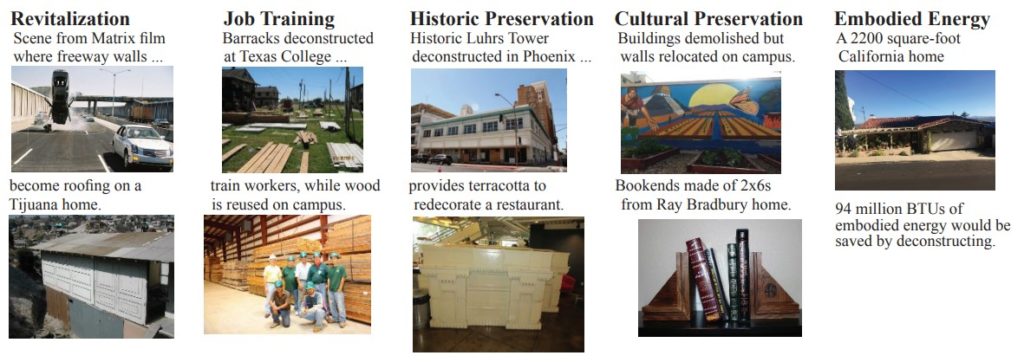Donating building materials that have been salvaged through deconstruction is a smart, easy alternative to demolition. Just as when choosing an architect or building contractor, the focus should be on qualifying the candidates. This newsletter addresses the many benefits of deconstruction. The next two issues focus on qualifying deconstruction contractors, appraisers, and the organizations that receive salvaged materials, to ensure that those benefits are realized.
In the U.S. the number of single-family houses that are completely removed, whether by demolition or deconstruction, ranges from 250,000 to 300,000 per year, figures based on both governmental and private estimates. For commercial structures, the estimate is approximately 44,000 buildings. In this series I will restrict my comments to houses, and only to those that are reduced to dirt.
By various means, I would estimate that only 2,000 to 3,000 houses per year are fully deconstructed – a lowly one percent.
Sad? You bet, but there are several noteworthy reasons why deconstruction comes up short: disposal costs are absurdly low, salvage is a cottage industry with many small operators and little collaboration between them, older builders are often stuck in their customary ways, a pervasive focus on recycling tends to eclipse reuse, industry players fail to effectively sell reuse, and conflicting definitions of deconstruction confuse people, as do wide ranging estimates of price and time. Each one of these can be tough to overcome and collectively they make deconstruction difficult to sell.
Of all the benefits of deconstruction, the biggest driver is the tax benefit received by donating salvaged materials to a qualified nonprofit 501(c) organization. Still, even without tax savings, many attractive benefits accrue, including:
• Community revitalization. Donated materials help budget-minded families, first-time home buyers and owners of low to middle income rental units improve and maintain their properties.
• Reduced energy and emissions. All of the embodied energy (carbon) in salvaged materials is saved, which, by the way, is not the case with recycling.
• Reduced pollution. Deconstruction creates far less noise and dust (some of it lead) than demolition.
• Job training. Studies have shown that deconstruction employs three to five times as many people as demolition.
• Landfill preservation. New landfills almost always result in increased disposal fees.
• Historic/cultural preservation. Materials from historic buildings are reused rather than trashed.

More to come: Next month learn how to qualify competent deconstruction contractors, to maximize these great benefits.
